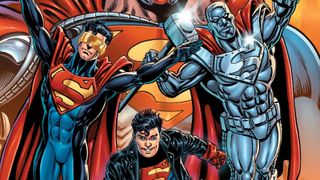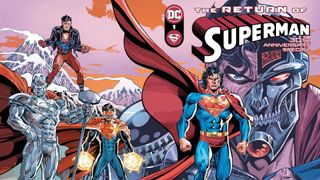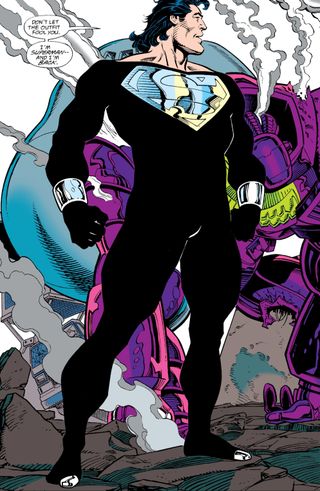
Just as last year marked the 30th anniversary of The Death of Superman, so 2023 heralds the 30th anniversary of the saga's epic conclusion.
DC is celebrating this milestone with a Return of Superman 30th Anniversary Special one-shot that reunites the original creative teams for new stories set in the wake of Superman's death. That's out now and is a lot of fun, but we're here today to talk about the original.
Written and illustrated by many of the same creators who killed the Man of Steel off the year prior, Superman's new lease of life came after four replacement heroes tried to fill the void he left behind in defending Metropolis. And while The Return of Superman (originally titled Reign of the Supermen!) is understandably overshadowed by The Death of Superman in both the public eye and sales charts, the 1993 storyline has arguably left a greater mark on the character's legacy than the Man of Tomorrow's untimely demise.
The hero died in November 1992's Superman #75 and officially came back to life in September 1993's Superman: The Man of Steel #25, less than a year later and after Superman comic titles took a three-month hiatus. Although it is one of the character's most famous stories, The Death of Superman is a flash in the pan, known primarily for its audacity in DC being willing to kill off its flagship superhero, even if only temporarily.
In the interim, Metropolis greeted Cyborg Superman, the Eradicator, Superboy, and Steel, four new heroes that either claimed to be Superman himself or who pledged to continue the Man of Steel's never-ending mission in his honor.

Superman's return provided a commentary on the state of the genre at the time, which was increasingly turning to edgy anti-heroes more than idealistic figures, with his resurrection serving as a reminder of what he brought to the genre that he popularized.
Superman would be slightly changed by his brief brush with death, becoming arguably more assertive than he had been before having faced his mortality head-on. Further highlighting this change was the longer hair that Superman sported in the immediate aftermath of his resurrection, a sign of the '90s times that was quietly dropped after several years when he reverted to his more classic appearance.
Comic deals, prizes and latest news
Get the best comic news, insights, opinions, analysis and more!
Within the comics, The Return of Superman effectively added two new heroes to the Superman mythos with Superboy and Steel - both still active today - while the Eradicator became something of a frenemy, alternating between antagonist and ally. Cyborg Superman firmly fell into the villains' camp, becoming a major foe for both Superman and Green Lantern moving forward.
The biggest consequence to The Return of Superman was Cyborg Superman destroying Coast City, with Hal Jordan losing his hometown and everyone he cared for. Hal became the villainous Parallax and was replaced by Kyle Rayner as the new Green Lantern - The Return of Superman brought back one major DC hero and caused the downfall of another.

In multimedia depictions of Superman, The Return of Superman has had an ongoing visible influence, from an outright adaptation of the comic book story to the inclusion of characters and designs introduced in it.
Steel would receive his own live-action film in 1997 starring Shaquille O'Neal as the metal-clad superhero, though its connections to Superman would largely be discarded. Conner Kent, the clone Superboy, played a pivotal role in the animated series Young Justice, caught between the legacy of his genetic progenitors Superman and Lex Luthor.
Visually, the black suit Superman first wears in The Return of Superman to recharge his body with solar energy has since taken on a life of its own. From appearing as alternate costumes in video games like Justice League Heroes and Injustice: Gods Among Us to both the Arrowverse on television and DC Extended Universe on the silver screen, the black suit heralds a much more serious and aggressive Superman in action. The Death of Superman may have centered on a Man of Steel fighting to the end, but the black suit he gains in The Return of Superman cemented his reputation as a more proactively violent hero when the occasion calls for it.

The Return of Superman never quite got the acclaim it deserved, either overshadowed by the preceding storyline or blamed for cheapening the impact of Superman's death in the first place. But the truth is Superman was never going to stay dead, certainly not permanently, and The Return of Superman serves as the bombastic culmination of themes The Death of Superman explored.
The Death of Superman took the Last Son of Krypton off the board, but it was The Return of Superman that reminded everyone why he truly mattered and continues to strongly inform the DC Universe 30 years later.
The Return of Superman 30th Anniversary Special is out now from DC.
Looking for a place to start with the Man of Steel? These are the best Superman stories of all time.
Sam is a freelance writer contributing to GamesRadar+. Sam has been working in entertainment journalism since 2016 for outlets including CBR, Popverse, /Film, and more, conducting interviews and writing reviews and columns covering comic books, television, film, and video games. With an expertise spanning the breadth of pop culture, Sam is especially knowledgeable on Star Trek, Nintendo, and DC Comics. In his free time, Sam likes to play guitar poorly and travel around the world.
Most Popular



